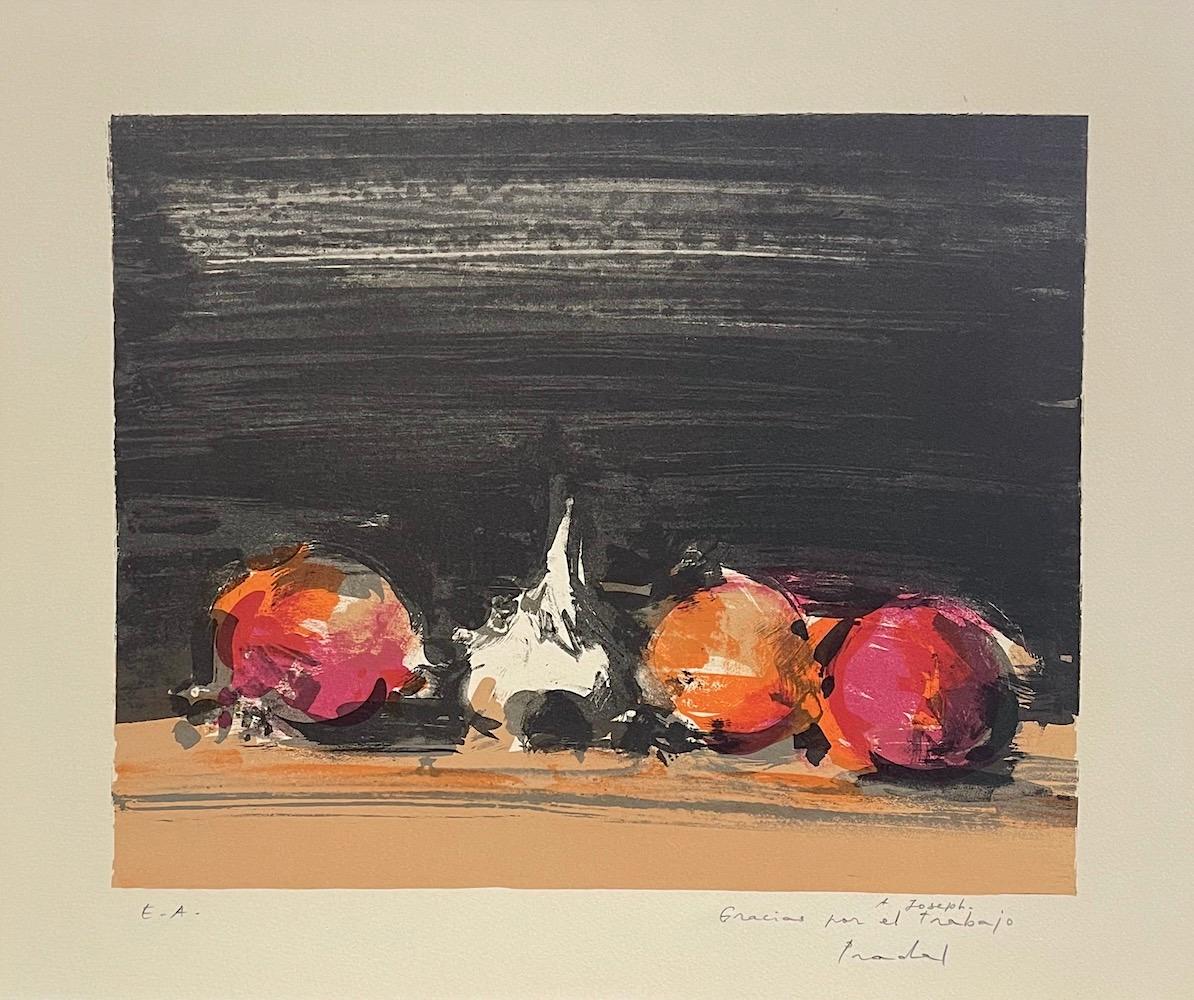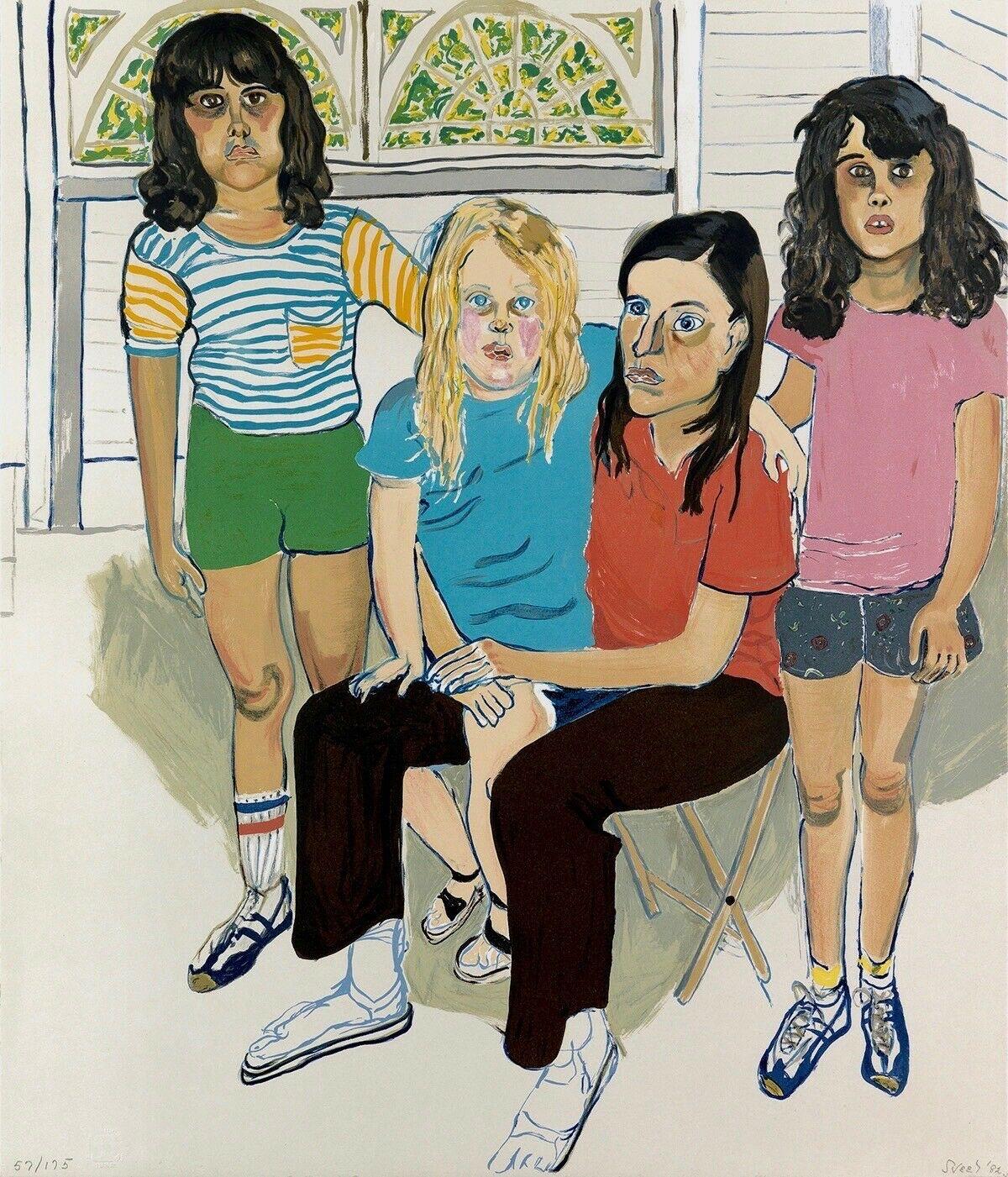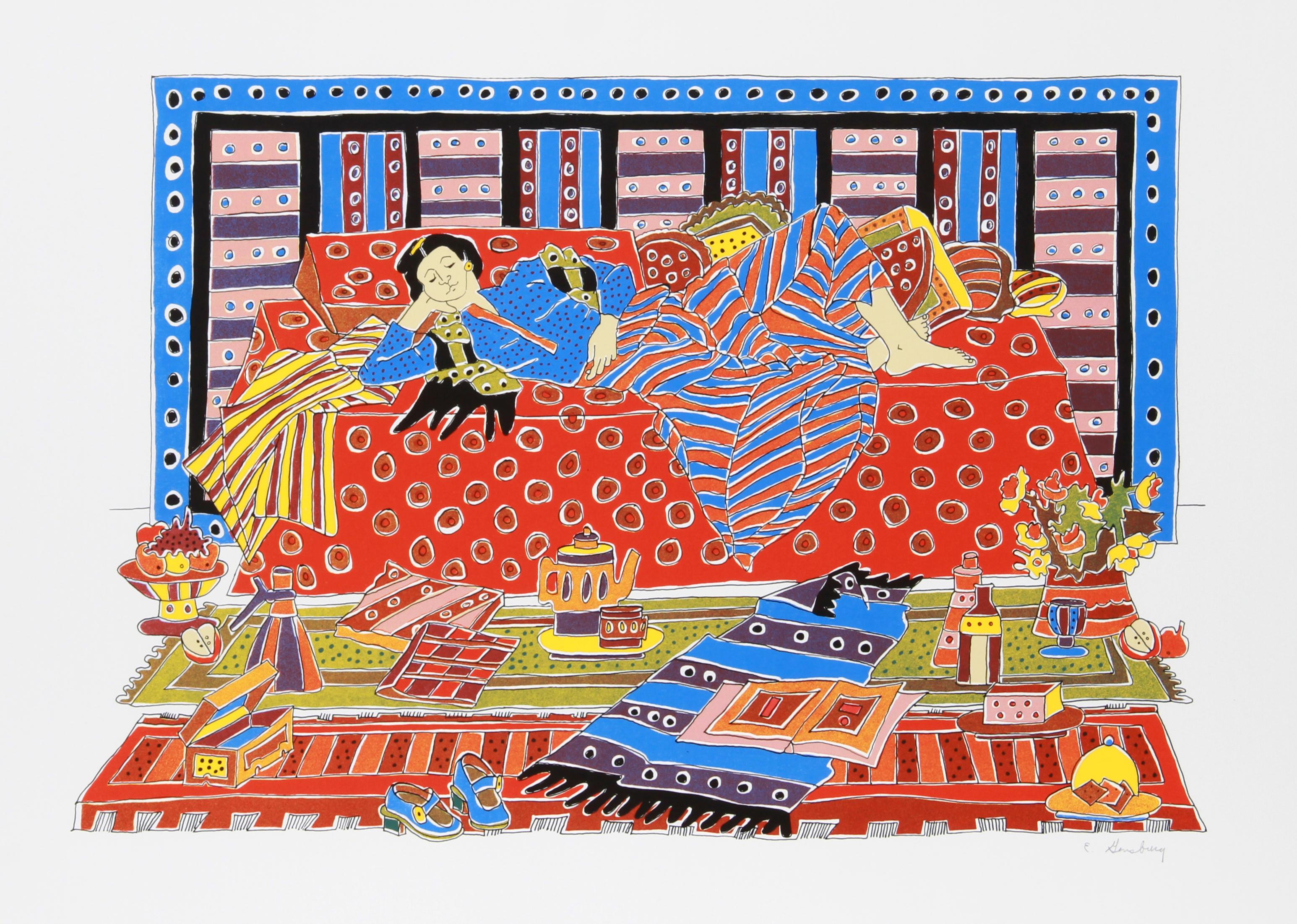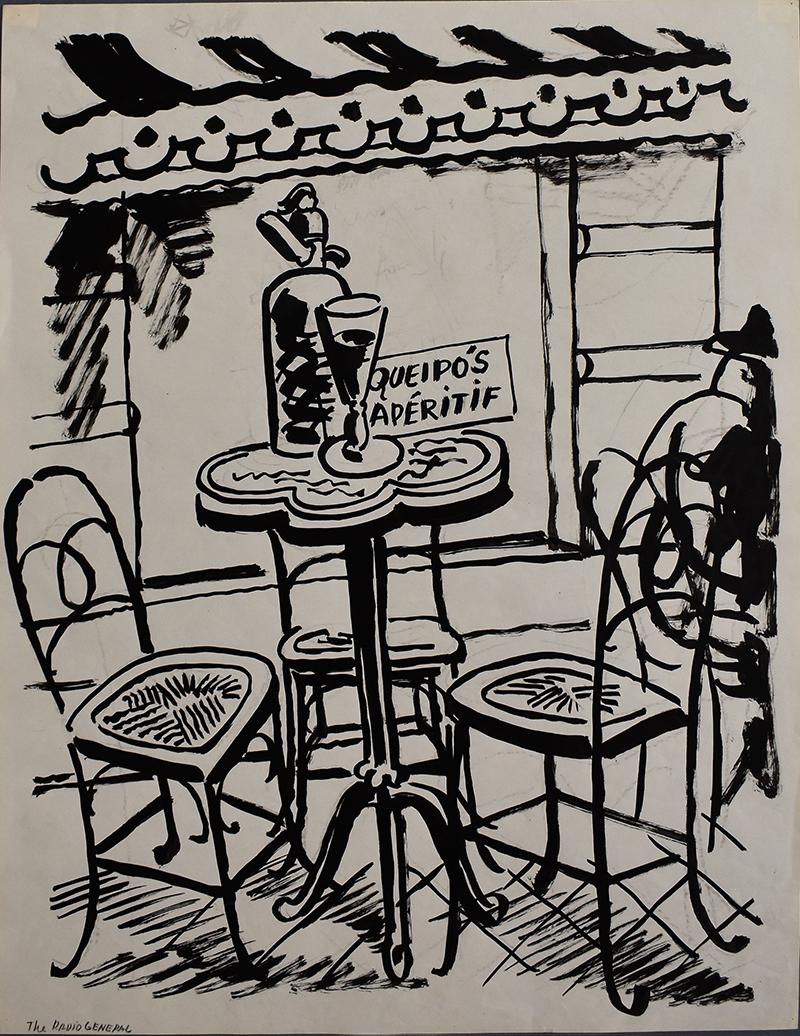Items Similar to In the Salon
Want more images or videos?
Request additional images or videos from the seller
1 of 10
Rudolf BauerIn the Salonc. 1910
c. 1910
About the Item
In the Salon
Lithograph on tan wove paper, c. 1910
Signed in pencil lower right; signed in the plate lower right (see photo)
Annotated "No. 20" in pencil lower left (see photo)
Condition: Excellent
Image size: 13-7/8 x 10-1/2 inches
Sheet size: 19 x 14 1/4 inches
Provenance: Estate of the Artist
Borghi & Co., New York
Herb Lerner, Boca Raton, FL
Rudolph Bauer
1889-1953
Rudolf Bauer was born in Lindenwald near Bromberg, Silesia, in 1889 but his family moved only a few years later to Berlin. In 1905 Bauer began his studies at the Berlin Academy of Art but left the Academy only a few months later to educate himself. The upshot was paintings, caricatures and comical drawings which were published in 'Berliner Tageblatt', 'Ulk' and 'Le Figaro'.
From 1912 Bauer contributed to the magazine and Gallery 'Der Sturm' founded by Herwarth Walden and pivotal to German Expressionism and the international avant-garde. In 1915 Rudolf Bauer participated for the first time in a group show at Walden's gallery. There he met Hilla von Rebay, with whom he began a relationship of many years that was crucial to Bauer's later work. By 1922 Bauer had shown work at about eight exhibitions mounted by 'Der Sturm'. From 1918 he also taught at the 'Der Sturm' art school, where Georg Muche was the director. After the war ended, Bauer was a founding member of the 'November Group' although he did not collaborate closely with the group. In 1919 Bauer joined forces with the painter and architect Otto Nebel and with Hilla von Rebay to found the artists' association 'Die Krater'. Impressionist at the outset, Bauer's early work reveals Cubist and Expressionist influences. By 1915/16 Bauer had switched to an abstract pictorial idiom, which is markedly influenced by Kandinsky. In the early 1920s Bauer was also preoccupied with Russian Constructivism as well as the Dutch de Stijl group. Bauer's decided preference for non-representational painting culminated in 1929 with the foundation of a private museum, 'Das Geistreich', which he directed as a salon for abstract art.
Political developments in Germany forced Bauer to sell some of his work in America from 1932. His agent in America was Hilla von Rebay, who was by now director of the Guggenheim Collection. In 1936 she organized a touring exhibition of non-representational European art that included sixty Rudolf Bauer oil paintings and watercolors. After Rudolf Bauer emigrated to the US in 1939, his work was exhibited several times at the Guggenheim Foundation before his death in 1953. Rudolf Bauer's comprehensive œuvre, which had been consigned to virtual oblivion after 1960 in both the US and Europe, has been enjoying a renaissance of interest worldwide since the 1980s.
Courtesy: www.Rudolph-Bauer
- Creator:Rudolf Bauer (1889-1953, German)
- Creation Year:c. 1910
- Dimensions:Height: 13.88 in (35.26 cm)Width: 10.5 in (26.67 cm)
- Medium:
- Movement & Style:
- Period:
- Condition:
- Gallery Location:Fairlawn, OH
- Reference Number:
Rudolf Bauer
The true story of Rudolf Bauer is perhaps one of the most complex, tragic, and ironic of 20th century art history. Rudolf Bauer was a pioneering German-born artist who, along with Vasily Kandinsky, was among the first abstract artists in the world. His “non-objective” abstract style would go on to influence virtually all aspects of modern art and serve as a beacon to Pollock, Rothko, and other artists who formed the New York school of Abstract Expressionism. In the first half of the 20th century, Bauer’s works were displayed alongside such luminaries as Picasso, Chagall, Miró, Mondrian, and Kandinsky, in numerous galleries and museums throughout the world. However by the end of World War II, Bauer had stopped painting and fell into obscurity.
About the Seller
5.0
Recognized Seller
These prestigious sellers are industry leaders and represent the highest echelon for item quality and design.
Platinum Seller
These expertly vetted sellers are 1stDibs' most experienced sellers and are rated highest by our customers.
Established in 1978
1stDibs seller since 2013
712 sales on 1stDibs
Typical response time: 1 hour
Associations
International Fine Print Dealers Association
- ShippingRetrieving quote...Ships From: Akron, OH
- Return PolicyA return for this item may be initiated within 10 days of delivery.
More From This SellerView All
- En passant (Passing by)By Louis LegrandLocated in Fairlawn, OHEn passant (Passing by) Drypoint, 1909 Unsigned (as issued in the deluxe portfolio) From the album "Les Bars" (8 plates plus cover illustration) Edition: 30, this state with remarque Published by Gustav Pellet, Paris A very rich impression wwith burr Condition: Excellent Image/Plate size: 9 7/8 x 6 3/8 inches Reference: Arwas 391a (remarque) Exteens 277 i/II IFF 148 (portfolio) Louis Auguste Mathieu Legrand (29 September 1863 – 1951) was a French artist, known especially for his aquatint engravings, which were sometimes erotic. He was awarded the Légion d'honneur for his work in 1906. Life Legrand was born in the city of Dijon in the east of France. He worked as a bank clerk before deciding to study art part-time at Dijon's Ecole des Beaux-Arts. He won the Devosge prize at the school in 1883.[2] In 1884 Legrand studied engraving under the Belgian printmaker Félicien Rops. Legrand's artworks include etchings, graphic art and paintings. His paintings featured Parisian social life. Many were of prostitutes, dancers and bar scenes, which featured a sense of eroticism. According to the Hope Gallery, "Louis Legrand is simply one of France's finest early twentieth century masters of etching." His black and white etchings especially provide a sense of decadence; they have been compared to those of Henri de Toulouse-Lautrec, though his drawings of the Moulin Rouge, the can-can dance and the young women of Montmartre preceded Toulouse-Lautrec's paintings of similar scenes. He made over three hundred prints of the night life of Paris. They demonstrate "his remarkable powers of observation and are executed with great skill, delicacy, and an ironic sense of humor that pervades them all." Two of his satirical artworks caused him to be tried for obscenity. The first, "Prostitution" was a symbolic drawing which depicted a naked girl being grasped by a dark monster which had the face of an old woman and claws on its hands; the second, "Naturalism", showed the French novelist Émile Zola minutely studying the thighs of a woman with a magnifying glass. Defended by his friend the lawyer Eugène Rodrigues-Henriques (1853–1928), he was found not guilty in the lower court, but was convicted in the appeal court and then given a short prison sentence for refusing to pay his fine. Legrand was made famous by his colour illustrations for Gil Blas magazine's coverage of the can-can, with text by Rodrigues (who wrote under the pseudonym Erastene Ramiro). It was a tremendous success, with the exceptional quantity of 60,000 copies of the magazine being printed and instantly sold out in 1891. In 1892, at the instigation of the publishing house Dentu, Legrand made a set of etchings of his Gil Blas illustrations. The etchings were published in a book, Le Cours de Danse Fin de Siecle (The End of the Century Dance Classes). Legrand took a holiday in Brittany, which inspired him to engrave a set of fourteen lithographs of simple country life called Au Cap de la Chevre (On Goat Promontory). It was published by Gustave Pellet who became a close friend of Legrand's. Pellet eventually published a total of 300 etchings by Legrand, who was his first artist; he also published Toulouse-Lautrec and Félicien Rops among others. He did not only work in graphics; he exhibited paintings at the Paris salon of the Société Nationale des Beaux-Arts starting in 1902. In 1906 he was made a chevalier of the Légion d'honneur. Legrand died in obscurity in 1951. A retrospective exhibition was held at the Félicien Rops museum in Namur, Belgium in 2006 to celebrate his graphic art. The art collector Victor Arwas published a catalogue raisonné for the occasion. Books illustrated de Maupassant, Guy: Cinq Contes Parisiens, 1905. Poe, Edgar Alan: Quinze Histoires d'Edgar Poe...Category
Early 1900s Art Nouveau Interior Prints
MaterialsDrypoint
- La Negresse (The Negress)By Louis LegrandLocated in Fairlawn, OHLa Negresse (The Negress) Etching & drypoint, 1909 Unsigned (as issued in the portfolio) From the album "Les Bars" (8 plates plus cover illustration) Editi...Category
Early 1900s Art Nouveau Interior Prints
MaterialsEtching
- Actresses in Their Dressing RoomsBy Edgar DegasLocated in Fairlawn, OHActresses in Their Dressing Rooms etching & aquatint, 1879-1880 Unsigned as usual for all canceled plate impressions Reference: Delteil 28, Shapiro 50 vi/vi with the cancelation line...Category
1870s Impressionist Interior Prints
MaterialsAquatint
- The Art of Conversation (Three characters on...)By Marcel GromaireLocated in Fairlawn, OHThe Art of Conversation (Three characters on...) Etching, 1958 Signed in pencil lower right: “Gromaire” (see photo) Edition: 110 (18/110) see photo Printed on RIVES paper Publisher: ...Category
1950s Cubist Interior Prints
MaterialsEtching
- The So-Called Tempio della Tosse, Near Tivoli. Interior UprightBy Giovanni Battista PiranesiLocated in Fairlawn, OHThe So-Called Tempio della Tosse, Near Tivoli. Interior Upright (Veduta interna del Tempio della Tosse) "Temple of the Cough" Etching, 1764 Signed in the plate From: Vedute di Roma...Category
1760s Old Masters Interior Prints
MaterialsEtching
- St. Peter's Interior with the NaveBy Giovanni Battista PiranesiLocated in Fairlawn, OHSt. Peter's Interior with the Nave Veduta interna della Basilica di S. Pietro in Vaticano Etching, 1748 Signed in the plate From: Vedute di Roma, Plate 5 An early Roman...Category
1740s Old Masters Interior Prints
MaterialsEtching
You May Also Like
- SPANISH STILL LIFE WITH GARLIC Signed Stone Lithograph, Red, Orange, Tan, BlackLocated in Union City, NJSPANISH STILL LIFE WITH GARLIC by the Spanish artist Carlos Pradal, is an original hand drawn, stone lithograph printed by hand in Paris France using traditional hand lithography techniques on buff color archival printmaking paper, 100% acid free. SPANISH STILL LIFE WITH GARLIC presents an expressionist-style still life vegetable portrait depicting round onions with a head of garlic positioned toward the center. A broad sweeping brushstroke wash of charcoal black dominates the background creating a dramatic staging for the red and orange vegetable shapes; the off white color of the paper forms the garlic bulb creating contrast for this expressive, energetic Spanish still life composition. Print size - 17 x 20.25 inches, unframed, very good condition, pencil signed by Pradal, inscribed E.A.(Epreuve Artiste) with personal dedication to the master printer Image size - 13 x 16.25 inches Year - c. 1974 About the artist: Carlos Pradal(1923-1988) Spanish ceramist, painter and illustrator was the son of Republican deputy Gabriel Pradal from Almeria, Andalusia. In 1939, his family was forced into exile and settled in France, in Toulouse. In 1956 he obtained a Spanish license and became an auxiliary teacher. He practiced drawing and painting at the same time, following the lessons of Raoul Bergougnan. In 1972, he moved to Paris, where he became a friend of the painters Peinado and Orlando Pelayo. When Franco died...Category
1970s Expressionist Still-life Prints
MaterialsLithograph
- The Family, Alice NeelBy Alice NeelLocated in Fairfield, CTArtist: Alice Neel (1900-1984) Title: The Family Year: 1982 Medium: Lithograph on Arches paper Edition: 57/175, plus proofs Size: 31.25 x 27 inches Condition: Excellent Inscription: ...Category
1980s Expressionist Figurative Prints
MaterialsLithograph
- Klimt, Lithograph by Estelle GinsburgLocated in Long Island City, NYKlimt Estelle Ginsburg, American Date: circa 1979 Screenprint, signed and numbered in pencil Edition of 500, AP 50 Size: 21.5 in. x 29 in. (54.61 cm x 73.66 cm)Category
1970s Expressionist Figurative Prints
MaterialsLithograph
- Women of Intellect #6, Lithograph by Estelle GinsburgLocated in Long Island City, NYArtist: Estelle Ginsburg, American Title: Women of Intellect #6 Year: 1978 Medium: Lithograph, signed and numbered in pencil Edition: 150 Size: ...Category
1970s Expressionist Figurative Prints
MaterialsLithograph
- HomeLocated in Ibadan, Oyo"Home" is a thought-provoking artwork created by Lawal Ibrahim that portrays a man sitting on a chair in a contemplative stance. The piece stands as an e...Category
21st Century and Contemporary Expressionist Figurative Prints
MaterialsBallpoint Pen, Digital, Paper
- The Radio GeneralBy (after) George GroszLocated in London, GBGEORGE GROSZ 1893-1959 1893 - Berlin - 1959 (German/American) Title: The Radio General, 1937 Technique: Titled India Ink Drawing on Thin Wove Paper Size: 66.7 x 48.3 cm. / 26.3 x...Category
1930s Expressionist Interior Prints
MaterialsIndia Ink





